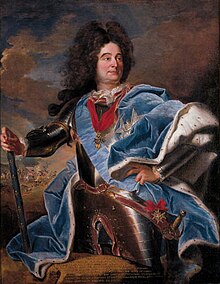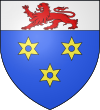Claude Louis Hector de Villars, 1st Duke of Villars
Claude Louis Hector de Villars | |
|---|---|
 Portrait by Hyacinthe Rigaud, 1704 | |
| Secretary of State for War | |
| In office 1 October 1715 – 24 September 1718 | |
| Monarch | Louis XV |
| Preceded by | Daniel Voysin de la Noiraye |
| Succeeded by | Claude le Blanc |
| Personal details | |
| Born | 8 May 1653 Moulins, Kingdom of France |
| Died | 17 June 1734 (aged 81) Turin, Kingdom of Sardinia |
| Spouse | Jeanne Angélique Roque |
| Children | Honoré Armand de Villars |
| Parents |
|
| Signature | |
| Military service | |
| Allegiance | |
| Branch/service | French Army |
| Years of service | 1671–1734 |
| Rank | Marshal General |
| Battles/wars | Franco-Dutch War Nine Years' War
|
 | |
Claude Louis Hector de Villars, Prince of Martigues, Marquis then (1st) Duke of Villars, Viscount of Melun (French pronunciation: [klod lwi ɛktɔʁ də vilaʁ], 8 May 1653 – 17 June 1734) was a French military commander and an illustrious general of Louis XIV of France.[1] He was one of only six Marshals to have been promoted Marshal General of France.
Early career
[edit]Villars was born at Moulins (in the present-day département of Allier)[2] in a noble but poor family, his father was the diplomat[2] Pierre de Villars. He entered the French army through the corps of pages in 1671 and distinguished himself at the age of twenty in the Siege of Maastricht in 1673 during the Franco-Dutch War and again at the bloody Battle of Seneffe. A year later he was promoted on the field to mestre de camp (colonel) of a cavalry regiment.[2]
The next promotion would take time in spite of a long record of service under Turenne, The Great Condé and Luxembourg, and of his aristocratic birth, as he had incurred the enmity of the powerful Louvois. He was finally made maréchal de camp in 1687.[citation needed]
In the interval between the Dutch wars and the formation of the League of Augsburg, Villars, who combined with his military gifts the tact and subtlety of a diplomat, was employed in an unofficial mission to the court of Bavaria, and there became the constant companion of Maximilian II Emanuel, Elector of Bavaria.[citation needed]
He returned to France in 1690 and was given a command in the cavalry of the army in Flanders, but towards the end of the War of the Grand Alliance, in 1698, he went to Vienna as ambassador.[2]
War of the Spanish Succession
[edit]
It was Villars' part in the next war, beginning with Friedlingen (1702) and Hochstadt (1703) and ending with Denain (1712), that has made him most famous.[citation needed] For his part in the battle of Friedlingen he received the marshalate, and for the pacification of the insurgent Cévennes he received the Saint-Esprit order and the title of duke. Friedlingen and Hochstadt were barren victories, and the campaigns of which they formed were characterised by lost opportunities. Villars' career culminated from 1709 onwards when France, close to total defeat, managed to survive.[2]
In that year he was called to command the main army opposing Prince Eugène of Savoy and Marlborough on the northern frontier.[2] During the famine of the winter he shared the soldiers' rations. When the campaign opened the old Marshal Boufflers volunteered to serve under him, but they were unable to prevent the Allies from capturing Tournai and Mons.[3] After the Battle of Malplaquet in September 1709, in which Villars was gravely wounded (by a musketball to the knee), he was able to tell the king: "If God grants us the grace to lose such a battle again, Your Majesty can count on all of his enemies being destroyed".[4]
Two more campaigns passed without a battle and with scarcely any advance on the part of the invaders, but at last Marlborough manoeuvred Villars out of the famous Ne plus ultra lines, and the power of the defence seemed to be broken. But Louis made a last effort, the English contingent and its leader were withdrawn from the enemy's camp, and Villars, though still recovering from his Malplaquet wounds, outmanoeuvred and decisively defeated Eugène at Denain.[2] The French followed up this success by retaking several lost fortresses, culminating in the Siege of Bouchain (1712).
This victory saved France, though the war dragged on for another year, where Villars led the Rhine campaign (1713), in which he took Landau,[citation needed] led the stormers at Freiburg and negotiated the Treaty of Rastatt and the Treaty of Baden[5] with Prince Eugène.[2]
As a result of his contribution, his title was granted Grandee of Spain status by Philip V.
Villars residence
[edit]Villars, named for Marshal Villars, was built in Moulins, Allier during the reign of Louis XV. The 18th century historical monument was used as a cavalry barracks.[6][7][8][9] It was partially destroyed during World War II[6] and was restored by François Voinchet, Architect of Historic Monuments and is now the Centre National du Costume de Scene museum.[10]
Regency
[edit]
Villars played a conspicuous part in the politics of the Regency period as the principal opponent of Cardinal Dubois, and only the memories of Montmorency's rebellion prevented his being made constable of France.[citation needed] He took the field for the last time in the War of the Polish Succession (1734), with the title marshal-general of the king's armies, that Turenne had held before him. But he was over eighty years old at this point, and after opening the campaign energetically he died at Turin on 17 June 1734.[2]
Marriage and issue
[edit]On 1 February 1702, he married Jeanne Angélique Roque with whom he had a son:
- Honoré Armand de Villars, 2nd Duke of Villars (4 October 1702 - May 1770) married Amable Gabrielle de Noailles and had a daughter.
Legacy
[edit]Villars's memoirs show us a fanfaron plein d'honneur, as Voltaire calls him. He was indeed boastful, and also covetous of honours and wealth. But he was also described as an honourable man of high courage, moral and physical, and certainly a very skilled soldier. He was famous for his love for young men as wrote the Duchess of Orleans in her letters.[11]
The memoirs, part of which was published in 1734 and afterwards several times republished in untrustworthy versions, were for the first time completely edited by the Marquis of Vogüé in 1884–92.[citation needed]
References
[edit]- Sturgill, Claude C., Marshal Villars and the War of the Spanish Succession, [Lexington]: University of Kentucky Press, [1965].
- ^ Lynn. A John. The French Wars 1667–1714: The Sun King at War. Osprey Publishing (2002) p. 62
- ^ a b c d e f g h i One or more of the preceding sentences incorporates text from a publication now in the public domain: Chisholm, Hugh, ed. (1911). "Villars, Claude Louis Hector de". Encyclopædia Britannica. Vol. 28 (11th ed.). Cambridge University Press. pp. 76–77.
- ^ MacDowall, Simon (2020). Malplaquet 1709: Marlborough's Bloodiest Battle. Bloomsbury Publishing. p. 39. ISBN 9781472841216.
- ^ Anquetil, Louis-Pierre (1819). Histoire de France depuis les Gaulois jusqu'à la mort de Louis XVI. Chez Janet et Cotelle. p. 241.
- ^ For a vivid description of Claude Louis Hector de Villars' stay during the Baden peace conference see: Das Diarium des Badener Friedens 1714 von Caspar Joseph Dorer. Mit Einleitung und Kommentar herausgegeben von Barbara Schmid (= Beiträge zur Aargauer Geschichte. 18). Baden: Hier und Jetzt, 2014, ISBN 978-3-03919-327-1.
- ^ a b "Historique". Centre National du Costume de Scene. Archived from the original on 17 December 2013. Retrieved 16 December 2013.
- ^ "Centre National du Costume de Scene". Saatchi Gallery. Archived from the original on 17 December 2013. Retrieved 16 December 2013.
- ^ Philip Jodidio (2004). Architecture D'aujourd'hui. Taschen. p. 533. ISBN 978-3-8228-2935-6.
- ^ "Centre National du Costume de Scene (French, translated in part using translate.google.com)". Ville de Moulins. Archived from the original on 8 July 2015. Retrieved 16 December 2013.
- ^ "Le Centre National du Costume de Scène de Moulins: une réalisation exemplaire". La Tribune de l'Art. Retrieved 16 December 2013.
- ^ Didier Godard, Le Goût de Monsieur. L'homosexualité masculine au XVIIe siècle, Montblanc, ed. H & O, 2002, p. 171


 French
French Deutsch
Deutsch